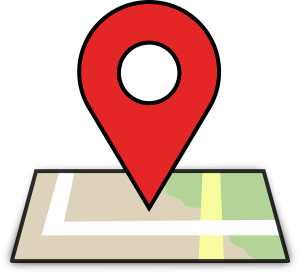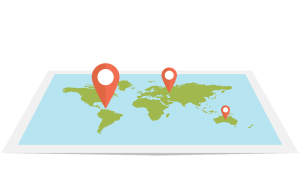We love web feeds. They keep us up to date with what is going on in the world. We always have the latest information on the subjects that we are interested in. Examples of web feeds are news articles and video and audio blogs. You can also find information feeds that show you certain information in a geospatial context.
On this page, you find what you need to add your GeoRSS feed to your personal or business website. You will need a content management system to publish your website, as well as a map rendering service, and you need to add GeoRSS code to your website.
Web Mapping Platforms

Google Maps is one of the most popular sources of digital visual geographical information. A big advantage of Google Maps is that the API is public so using it as part of a website is very easy. You can use it in combination with GeoCMS applications to display a map with information layers added to it. The result is an online interactive map where website visitors can extract relevant information.
MapServer is another option. This is an Open-Source engine for rendering different kinds of geographic data. Similar to Google Maps, you can use the MapServer-rendered maps to add different layers with extra information. These layers can be used to link to different websites and information sources. MapServer started as a project developed by groups at the University of Minnesota, the Minnesota Department of Natural Resources, and NASA. After the initial development, it was transferred to the TerraSIP project, which is a NASA-subsidized consortium.
Geospatial Management Systems
If you want to include an interactive map with updated information on your website, you will need a specialized geospatial management system or a GeoCMS. This system can add objects like images and articles to a map. You can define the latitudinal and longitudinal coordinates for displaying those items.
More advanced examples of geospatial management systems will also allow you to add other items to an interactive online map. You can think here of points, lines, and polygons that can indicate relationships between the different displayed items.
There are different examples of Content Management Systems that are compatible with different geo content syndication formats. Here are some of them:
- WordPress
- Plone
- Midgard
- Django
- Drupal
- Tiki Wiki CMS Groupware
RSS, XML, and Atom are technologies for publishing. Syndication is a process, examples of which are GeoJSON, GeoRSS, and KML.
GeoRSS in particular is compatible with Drupal, WordPress, and Midgard, which represents a selection of the most popular content management systems.
What Is GeoRSS?

GeoRSS is a specific element of web feeds that encodes for locations. The name derives from Geo and RSS which is one of the best-known web feed formats. GeoRSS defines location using geographical points and lines and adds relevant feature information to it. The format can be read by map generators and translated into understandable visible map renderings. The purpose is that the GeoRSS information is generally accessible and available. Most people will be able to see the rendered maps in their web browsers. It works in conjunction with RSS and Atom for generating web feeds.
There are currently three encodings in use:
-
- GeoRSS Geography Markup Language or GeoRSS GML. GML is the more elaborate of the two. It supports a wider variety of features, such as different latitude/longitude reference systems. GML is a product of the Open Geospatial Consortium (OGC), which is an organization that promotes the availability of geospatial information. It connects individuals, companies, and other organizations that have an interest in the subject. An example from the OGC website of the way GeoRSS GML codes is:
45.256 -71.92
- W3C GeoRSS serialization. This is an older encoding system whose use is not encouraged by experts. It has but gone into disuse.
- GeoRSS Simple. This is a more lightweight version of GeoRSS GML. It essentially supports basic geometry descriptors, like lines, boxes, points, and polygons. This simplified GeoRSS version suffices for most typical applications. The simplicity of GeoRSS is clear when compared with the coding of the same information in GeoRSS GML above. GeoRSS Simple allows developers to quickly implement geospatial information in their work. The examples are written in XML, but they are also expressible in XHTML, Java, and RDF. An example of the way GeoRSS Simple codes is:
45.256 -71.92
The major advantage of GeoRSS is that it allows for searching and compiling. With GeoRSS, you can search for all kinds of geographic parameters. Some other formats only allow you to search for a city or postal code. GeoRSS opens up the possibility to add information that is not related to geospatial parameters. You could for example search for things like earthquakes near you and you can have that information delivered to you. A useful application could also be traffic information. You can get the latest traffic updates on your phone right before you leave for work.
History of GeoRSS
The basis for RSS Web feeds was laid in 1997 by Dave Winer and implemented in 1999 in the infamous late Netscape web browser. That focused on simple applications, like news and blogs.
In 1999, Andrew Daviel founded Geotags. Links were then made between the existing RSS feeds and geographical locations. In 2002, the first geo-enabling RSS was published by Chris Goad. About a year later, the first concept of GeoRSS was presented by Josh Liebman, which term was later registered by Raj Singh.
Examples of GeoRSS

There are many examples. Here are a couple of classical websites that popularized its use.
Geonames.org contains more than 11 million place names. You can use and download from geonames.org for free.
The United States Geological Survey started to send out earthquake alerts using GeoRSS feeds in 2004. Similar feeds were initiated for tsunami alerts.
Triptracker offers a service with which you can track your journeys. Now, it has a specialized application.
GeoRSS Model
GeoRSS is identified by the name “georss:”. You can include other elements from different namespaces. You need to express them in forms like RDF, XML, or something similar. These are known as serializations.
As mentioned, you can use more than serialization at a time. However, they need to conform to the GeoRSS model to be related to each other. That allows them to be used on different platforms. GeoRSS Simple in particular has a simple and concise design. Both the concept and representation are largely reduced compared to GeoRSS GML. This has as a consequence that tagging is limited, and that compatibility is reduced. However, for most applications, GeoRSS Simple is an adequate model. It also supports geometries like points, lines, polygons, and boxes. In addition to those features, GeoRSS supports elevation and radius coding. The radius is always used in conjunction with a point.
Enhancing Online Experiences with GeoRSS
In the realm of web feeds, GeoRSS isn’t just about geographical points and lines; it’s about enhancing user experiences across various online domains. Beyond traditional uses like news updates and journey tracking, GeoRSS can also play a pivotal role in activities such as online gambling.
Imagine a scenario where users can track the latest updates on live casino events or locate nearby poker tournaments right from their web browsers. GeoRSS enables precisely that. By incorporating GeoRSS feeds into online gambling platforms, players can effortlessly stay informed about upcoming events, jackpot locations, or even find nearby casinos to visit.
For instance, a popular online gambling website might utilize GeoRSS to display real-time updates on poker tournaments happening worldwide. Users could simply navigate to the website and explore an interactive map showcasing tournament locations, prize pools, and event schedules. This not only adds convenience for players but also enhances engagement and excitement in the online gambling community. Furthermore, GeoRSS can empower online gambling to offer personalized experiences based on users’ geographical locations. By integrating GeoRSS feeds, these platforms can tailor promotional offers, loyalty rewards, and game recommendations according to the user’s region, creating a more immersive and targeted gambling environment.
In essence, GeoRSS transcends conventional boundaries, extending its utility to diverse online domains, including the dynamic world of online gambling. By leveraging GeoRSS technology, gambling enthusiasts can immerse themselves in a world of unparalleled convenience, excitement, and endless possibilities—all with just a few clicks.
So, whether you’re a seasoned poker player seeking the next big tournament or a casual gambler looking for nearby gambling hotspots, GeoRSS opens up a world of opportunities to gamble online like never before.
WordPress and GeoRSS
It takes some effort to get used to writing GeoRSS code. Many of us do not have the time or energy to become diehard GeoRSS coders. There are different ways in which you can add GeoRSS feeds to your website without having to write a line of code yourself.
The most popular content management system available is WordPress. It is estimated that nearly 43% of all websites are built with WordPress. There are thousands of plug-ins available that allow the user to include different functionalities to websites without the need for writing code. There are also different WordPress plug-ins that can add maps and GeoRSS feeds to websites. Here is a brief selection of some of the most popular ones:
MapPress Easy Google Maps

This mapping plugin is one of the most popular ones available. With MapPress Easy Google Maps you can easily add Google Maps with location markers to your blog and make them look very professional.
It adds a Google Maps editor to the WordPress environment. You can search and modify the maps and then publish them on your website or blog.
It will do everything automatically for you. You don’t need to add any code to your website. Readers can find direction to the places that you are indicating. You can make custom HTML objects to add extra layers to your maps. You can include links, pictures, and much more.
Comprehensive Google Map Plugin
This plugin gives you intuitive and easy ways to incorporate Google Maps into your website. The professional maps are generated using a shortcode or a widget. This plugin is a full version and does not have functional limitations. It has a wide range of handy mapping features, including GeoRSS.
WP Geo
This popular geo plugin lets you add maps with highlighted locations to your WordPress post or page. While you are editing your post you can embed a map into your content and select a location. This is very easy. You can do it by clicking on a location, searching for a location, or by entering the coordinates.
WP Geo is fully compatible with the WordPress environment and very easy to install and work with.
Google Map Locations

Google Map Locations is another WordPress Plugin that lets you add Google Maps to your website or blog. On top of that, you can add locations and location descriptions using a bubble.
You can add information such as location, postal code, map coordinates, images, and much more. All the information will be added to the bubble. The bubble in turn is pinned to the selected location.
This plugin has an options panel with many features. You can customize your locations and information and add GeoRSS feeds.
GeoPress
You can add maps to your WordPress sites with GeoPress. You can add GeoRSS, KML, and other geographical extras to your maps.
One of the things that you can add that deserves attention is geographic tags. Simply, enter an address, and geographical coordinates, or click on the map to indicate what you want to highlight.
GeoPress is compatible with map rendering services like Google Maps, OpenStreet, Bing Maps, and 3D Globe. The plugin contains a library of available services that you can choose from. You can make GeoRSS feeds and add KML for Google Earth viewing.
Slick Google Map
The Slick WordPress plugin is simple and easy to use. It renders professional and elegant Google Maps that you can add to your website. You can use the associated shortcode or the widget.
With Slick Google Map WordPress Plugin, you get a large variety of handy features. These include KML support, GeoRSS, Geo Mashup, various marker icons, and much more.
Slick is free and open source. You don’t need to pay for an annual subscription. It is one of the most practical and complete free mapping plugins for WordPress.
Transportlines.com
Here we find another application of geotagging and GeoRSS feeds. It is the GPS tracking system provided by this plugin. You can show the exact location of your fleet in real-time on your website. You don’t need complicated software; you only need to turn on the GPS function on your mobile phone.
Besides the tracking option, you can add GPS location coordinates to your blog posts or your website. You can show KMZ or KML files to show the coordinates on a map. You can add pictures to the map and extract the location tags of the image files.
The plugin is fully compatible with all features of WordPress and the administration panel. It is intuitive and customizable to your needs.
